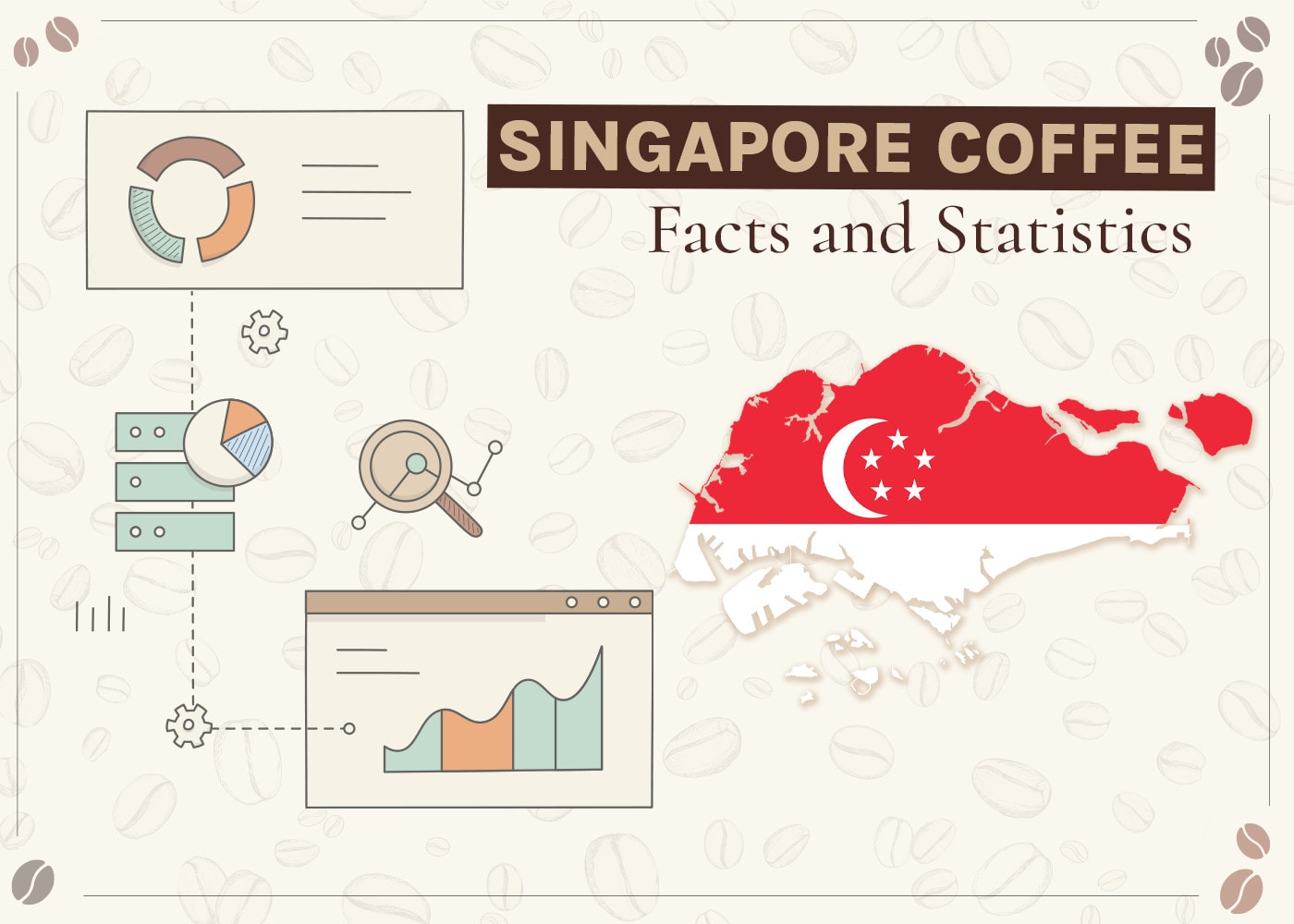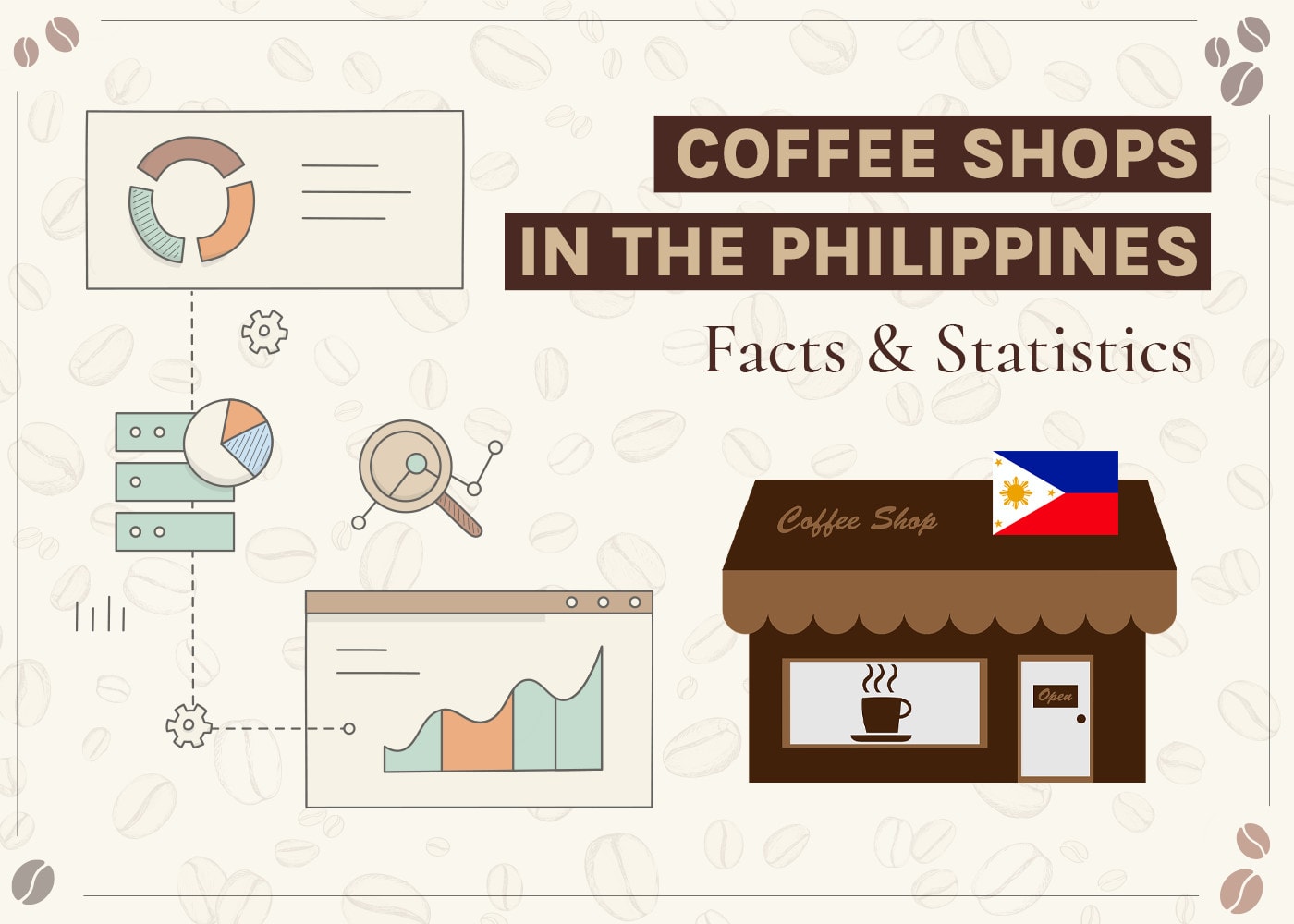
Note: This article’s statistics come from third-party sources and do not represent the opinions of this website.
Despite once being one of the most prolific coffee-producing countries and being one of the few nations in the world to produce all four varieties of coffee, the Philippines is now ranked outside the top 100 coffee-producing countries. Despite this, Filipinos have a love of coffee and while the country has long been renowned for its love of instant coffees, there is a growing number of coffee shops and an increased love of specialty and brewed coffee.
Covid saw the country’s love and purchase of coffee stall somewhat in 2020, but it is expected not only to return to pre-pandemic levels but to surge above them by 2025. Below are 12 statistics related to coffee and coffee shops in the Philippines.
Click below to jump ahead:

The 12 Coffee Shops In The Philippines Statistics
- Coffee was introduced to the Philippines in 1740.
- The average Filipino consumed 3.05kg of coffee in 2020.
- 70% of Philippine coffee shop coffee is imported.
- 5,000 metric tons of coffee is imported to the Philippines every year.
- The country produced just over 62,000 metric tonnes of coffee in 2019.
- Starbucks was the most popular coffee shop chain in 2020.
- Coffee Bean and Tea Leaf was a distant second.
- Philippines millennials are willing to spend P100 ($1.90) on a cup of coffee.
- It costs $3.02 for a cup of coffee in Manila.
- It costs up to $375,000 to open a coffee shop.
- Filipinos are projected to buy 3.78kg of coffee each, by 2025.
- The coffee market is expected to have a value of $1.33bn USD by 2025.
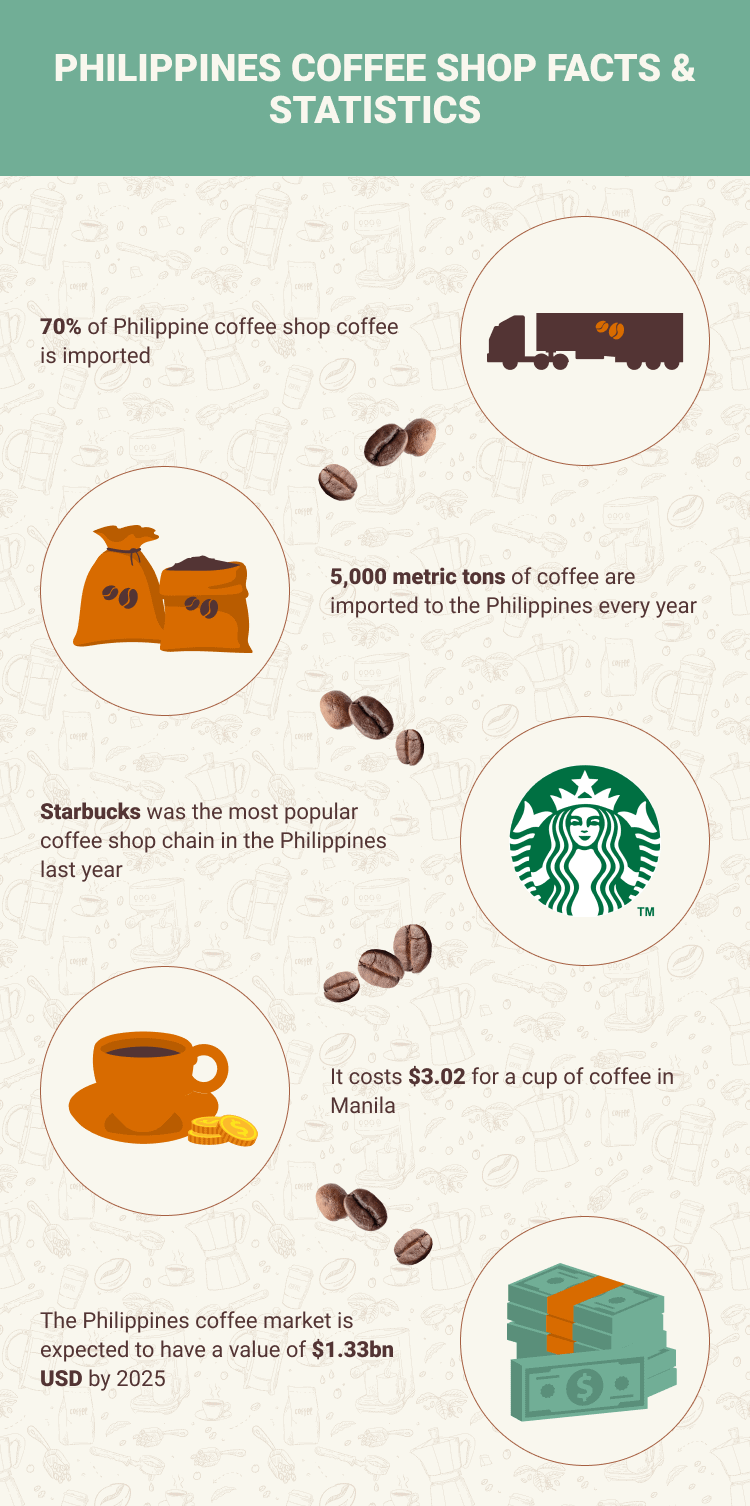

Coffee In The Philippines
1. Coffee was introduced to the Philippines in 1740.
(Nonneman)
Franciscan Monks planted the first coffee trees in the Philippines in 1740. The trees, which were a Mexican coffee variety, were planted in Lipa, Batangas, and by the 1860s coffee from the country was widely exported to America and, following the opening of the Suez Canal, to Europe. It was popular in the USA because it cost less to import from the Philippines than from other coffee-producing nations. By 1880, the Philippines had become the world’s 4th largest coffee bean exporter, but Coffee Rust decimated the country’s trees and production slid to 1/6th of its previous output by the turn of the 20th Century. Although coffee production was increased in the middle of the 20th Century, the Philippines has never really regained its status as one of the world’s most significant producers.
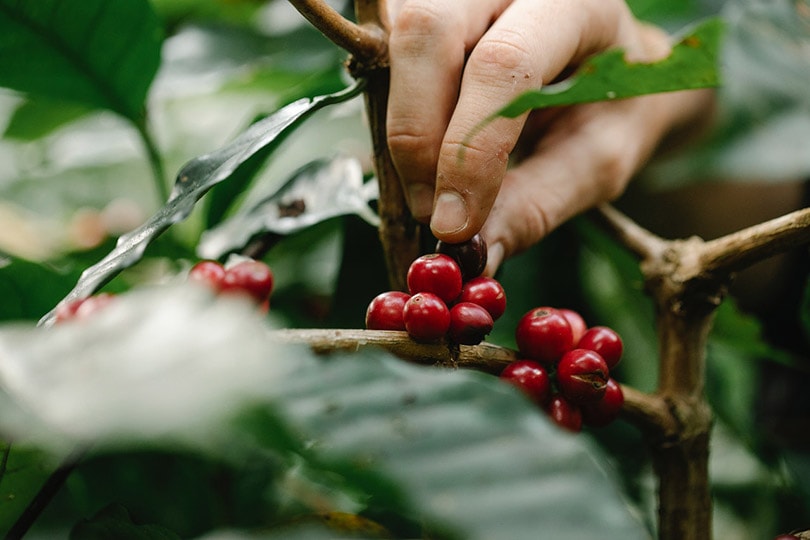
2. The average Filipino consumed 3.05 kg of coffee in 2020.
(PhilStar)
2020 and 2021 saw a significant change in the way people consumed coffee. Lockdowns and supply chain breakdowns, caused by the global Coronavirus pandemic, meant that more people enjoyed coffee from home, rather than coffee shops. This also had an effect in the Philippines, where consumption dropped from 3.4kg per capita in 2019 to 3.05kg per capita in 2020.
3. 70% of Philippine coffee shop coffee is imported.
(Business Mirror)
There are four types of commercially viable coffee – Arabica, Excelsa, Liberica, and Robusta. The Philippines is one of very few countries in the world that produces all four. Despite this, 70% of the coffee beans used in Philippine coffee shops is actually imported. Today, the country imports much of the coffee it consumes from Vietnam and Indonesia, although the increase in popularity of boutique and speciality coffee shops means that coffee lovers are consuming more of the country’s own coffee.

4. 5,000 metric tonnes of coffee is imported to the Philippines every year.
(Business Mirror)
Reduced coffee growing and increased coffee consumption mean that the country is more reliant on coffee imports than ever before, and 5,000 metric tonnes of the world’s second-most highly traded commodity (after oil) is shipped into the nation every year.
5. The country produced just over 62,000 metric tonnes of coffee in 2019.
(Vancouver PCG)
Filipinos consume nearly as much coffee as Americans every year and produce 62,000 metric tonnes of green beans, but they also consume 100,000 metric tonnes of coffee per annum. While more people are visiting coffee shops, the country’s preferred type of coffee drink is instant or soluble coffee.

Coffee Shop Statistics
6. Starbucks was the most popular coffee shop chain in 2020.
(Statista)
Starbucks has long been, and remains, the largest chain of coffee shops in the world, and this is true in the Philippines. In 2020, the chain generated just over $150 million USD of sales, putting it a considerable distance ahead of its competitors.
7. Coffee Bean and Tea Leaf was a distant second.
(Statista)
The second most popular coffee shop chain, in 2020, was Coffee Bean and Tea Leaf, but they only generated $17.54 million USD of sales, or approximately 12% of the sales of Starbucks during the same period. McCafe was the third most popular chain.
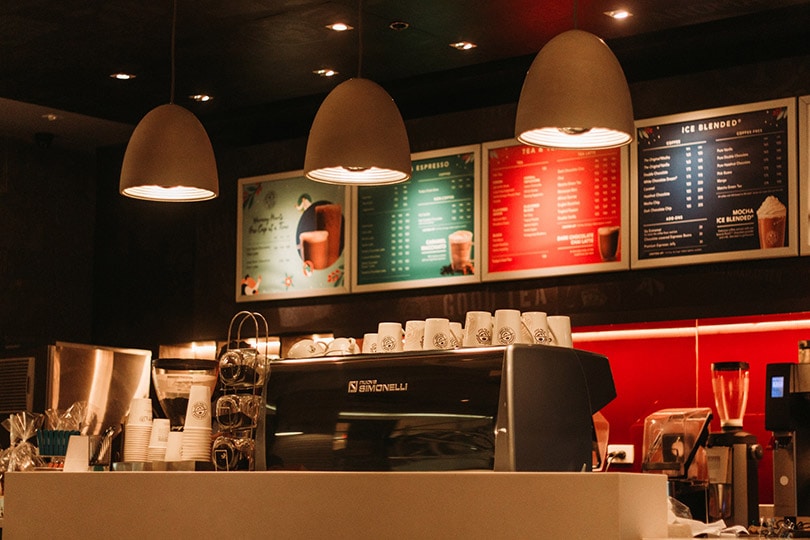
8. Philippines millennials are willing to spend P100 ($1.90) on a cup of coffee.
(Business Mirror)
As is true in most of the world, millennials are the age group driving demand for coffee shop coffee, and this group were willing, in 2018, to pay 100 Philippine peso for a single serving of coffee, equivalent to $1.90 per cup. Although that doesn’t sound much when compared to the likes of the US, the average monthly disposable salary in the Philippines is 1/10 that of the USA.
9. It costs $3.02 for a cup of coffee in Manila.
(CashNetUSA)
Manila, the country’s capital, is where you will find the largest number of coffee shops. The average price for a cup of coffee in the capital is just over $3 per cup.

10. It costs up to $375,000 to open a coffee shop.
(Nonneman)
The cost of opening a coffee shop in the country varies according to location, size, and type of premises. A coffee stand costs less than a full coffee shop. According to some estimates, potential coffee shop owners should expect to invest as much as $375,000 to open a coffee shop in the nation.
Philippine Coffee Forecast
11. Filipinos are projected to buy 3.78kg of coffee each, by 2025.
(PhilStar)
Although the pandemic has led to coffee consumption levels dropping to 3.5kg per person in 2020, those figures are expected to regain their pre-pandemic figures and continue to increase. By 2025, just 3 years away, the average coffee consumption figure, per capita, is expected to be 3.78kg, which is nearly a 25% increase over three years.

12. The coffee market is expected to have a value of $1.33bn USD by 2025.
(Market Research)
The increase in coffee consumption per capita, the amount paid per cup of coffee, and the rise in the number of coffee shops mean that the coffee market will grow considerably. It is expected to have a market value of $1.33bn USD by 2025, compared to $262 million USD in 2015 and represents an increase of 13.74% per annum over that period.

Frequently Asked Questions
What Is The Most Popular Coffee Shop In The Philippines?
Starbucks is the largest chain of coffee shops in the world, with more than 25,000 stores globally, in 2017. 298 of those stores were located in the Philippines, meaning the equivalent of 2.87 coffee shops per 1 million people. This puts it above countries like Greece and China, but it falls some way short of the 41 shops per million residents in the US and the incredible 52 branches per million people in Monaco. (Silver Door Apartments)

How Many Coffee Shops Are In The Philippines?
Although there are no figures that list the exact number of coffee shops in the country, in 2011, it was reported that there were more than 300 cafes and speciality coffee shops belonging to what were considered major coffee chains. This included 190 Starbucks, 62 Figaro, and 51 Bo’s Coffee coffee shops.
What Is The Coffee Capital Of The Philippines?
Coffee was first introduced to and first grow in the Batangas region of the Philippines and, even today, it is widely regarded as being the country’s coffee capital. Other regions, including Amadeo, a province of Cavite, also lay claim to being the most important coffee area.

Conclusion
Coffee is one of the most popular drinks in the Philippines and, as in the rest of the world, it continues to gain in popularity. Starbucks is the largest chain and seller of specialty coffee drinks in the country, while soluble or instant coffee remains the preferred method of consuming the coffee bean. Although consumption did take a hit during the pandemic, it is expected to recover and increase further by 2025, but, in 2020, the average Filipino consumed 3.05kg of the caffeinated beverage.
Featured Image Credit: decrand, Pixabay
Table of Contents
- The 12 Coffee Shops In The Philippines Statistics
- Coffee In The Philippines
- 1. Coffee was introduced to the Philippines in 1740.
- 2. The average Filipino consumed 3.05 kg of coffee in 2020.
- 3. 70% of Philippine coffee shop coffee is imported.
- 4. 5,000 metric tonnes of coffee is imported to the Philippines every year.
- 5. The country produced just over 62,000 metric tonnes of coffee in 2019.
- Coffee Shop Statistics
- Philippine Coffee Forecast
- Frequently Asked Questions
- Conclusion






